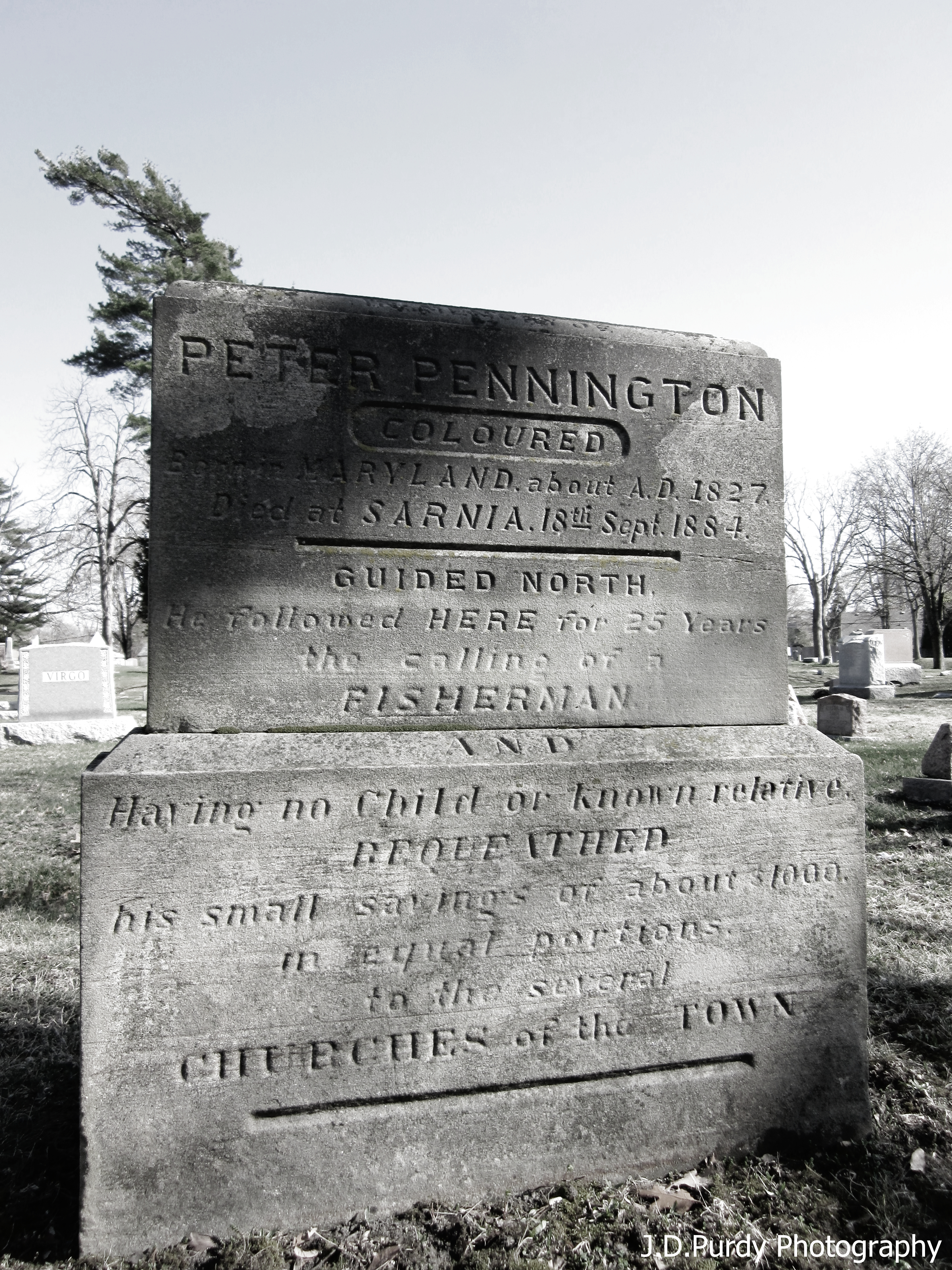by Phil Egan, Special to LambtonShield.com
Digital donation of picture by Joshua Purdy at Joshua Purdy Photography.
(2015) In a sea of graves at Lakeview Cemetery, there is no mistaking the Pennington headstone.
It marks its place in one of the very oldest of the cemetery’s sections, but this alone doesn’t make it different from the others. Its size is not unique; nor is its shape or colour. But it is unlike all the others, notwithstanding.
He was a fisherman, and a seller of fish. He was a Sarnian for many years– a pious man who left his entire $1,000 legacy, a small fortune, in the 1870s, to the city’s four oldest churches.
We can be thankful that his story is unlike yours, or mine – for the tale of how he came to live among us is fraught with terror, adventure, drama and danger.. It happened like this.
America in the 1850s was a powder keg waiting to explode. Sectional divisions between North and South were to blame. The South was convinced that their “peculiar institution,” slavery, was under assault by a northern community that simply didn’t understand the needs of the South.
Maryland, as a border state between the two soon-to-be warring factions, was at ground zero between the two sides. The bloodbath of the U.S. Civil War loomed just a few years ahead.
In Dorchester County, Maryland, a man named Turpin Wright owned two fisheries on the eastern shore of the county. He employed a crew of mixed labourers – some were simply paid workers, but others were not. Turbin “owned” fourteen slaves, and some of them were trained to help in his fisheries. One of these was a young black man named Peter Pennington.
On the first day of November, 1856, Pennington, then in his mid-20s, decided that he had had enough with the life of a slave. In the company of two brothers, Josiah and William Bailey, and a woman named Eliza Manokey, he fled Dorchester County for freedom in the North.
Their absence was noticed immediately. Wright and two other involved slave owners raced after the fugitives in hot pursuit. A reward of $2,600 was posted for the return of the fleeing slaves, which galvanized teams of slave catchers into additional pursuit. Pennington, who was described as being five feet, seven or eight inches tall with a dark chestnut complexion and wearing a black suit of clothing, was alone worth $800 of the reward money.
The journey to freedom was harrowing. Knowing that the usual escape route for fugitive slaves lay through the city of Washington, the pursuing slave owners raced to the capital city, arriving three days ahead of the fugitives and determined to cut off their escape.
Pennington and his fellow slaves, however, had one big advantage. Travelling with them was the organizer of their escape – a remarkable black woman named Harriet Tubman. Born into slavery in Dorchester County in 1813, Harriet had herself escaped for freedom seven years earlier. One of the architects of the famed Underground Railway, the series of safe houses in which fugitive slaves were hidden as they made their way north to freedom, she had continuously made her way back and forth to the county to rescue her family members and friends. Now, it was Peter Pennington’s turn.
Hiding among a load of bricks on a wagon driven by singing, shouting black bricklayers to throw off suspicion, the fugitives made their way to Philadelphia. Pennington continued farther north, putting even more distance between himself and his pursuers. With almost a month of hot pursuit behind them, Tubman and Pennington crossed the bridge over the Niagara River and entered Canada.
By 1871, Pennington was living in Sarnia, where he worked as a fish dealer. He lived and prospered here until his death in 1884. He now lies at Lakeview Cemetery. His grave marker is the only one in the county with the word “coloured” inscribed in large letters below his name. Lakeview’s Trevor Taylor says that the custom of the time was for blacks to have their own separate area in a cemetery. As Pennington was the only black resident of Lakeview at the time, the decision was made to so inscribe his grave marker.
Pennington left his entire estate of $1,000 to be divided by Sarnia’s four oldest churches. It was a considerable amount of money for the time. Today, his story is largely forgotten, yet his life is a valuable lesson for those among us who take life in our city for granted.
Peter Pennington put his life in danger to ultimately come to this city, to live in freedom beside a river and a lake. Here he worked his trade; the one that he had learned in captivity.
The story of Peter Pennington is a testament to the value of freedom. Some things are worth fighting for, and should not be taken for granted.


